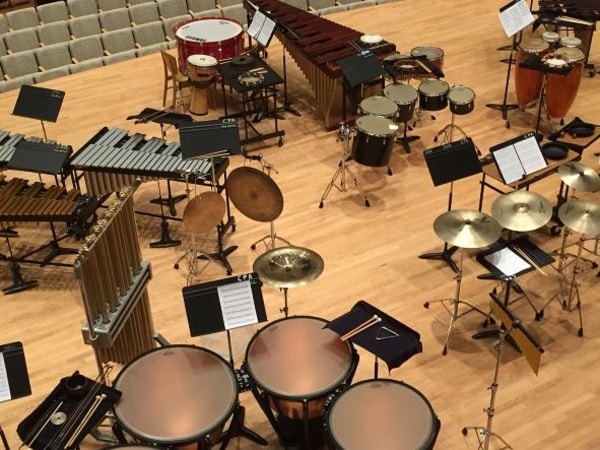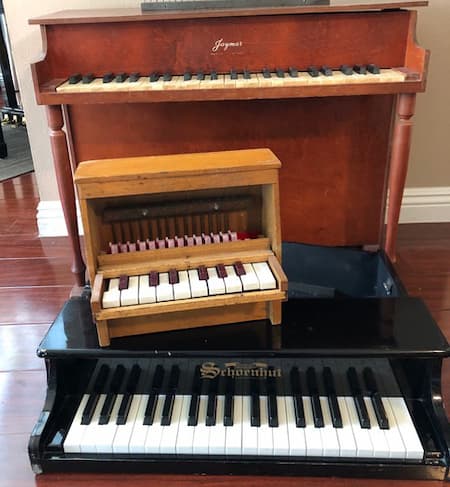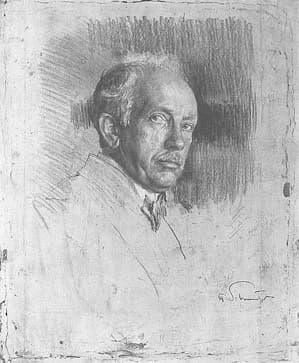The percussion section has to be the biggest section of the orchestra, not in terms of the number of players but of the number of instruments played.

To start with the basic definition, a percussion instrument is one that is sounded by being struck (like a drum) or scraped (like the musical saw or a rattle). Percussion instruments fall into 4 classes: idiophone, membranophone, aerophone, and chordophone.
Idiophones are sounded by the vibration of the instrument itself. Struck idiophones include the wood block, the singing bowl, the triangle, the glass harmonica, and the marimba. Bells and maracas are also idiophones.
Watching Tibetan bowls sing
Membranophones produce sound via a stretched membrane, such as drums of all kinds and the kazoo. Charles Ives’ A Song of Gambolier, from 1895, is a college song that ends with a kazoo chorus.
Charles Ives: A Son of a Gambolier (Ryan MacPherson, tenor; Ryan MacPherson, Lielle Berman, Daniel Trevlor Bircher, Sara Jakubiak, and Kelli Kathman, kazoo ; Jooyeon Kong, violin ; Ryan Johnstone and Cary Parker, trombone; Douglas Dickson, piano)
Aerophones produce sound via a vibrating column of air. The whistle and the thongophone, a group of long tubes of varying lengths, are sounded when a rubber clapper at the mouth of the pipe is struck. The Blue Man Group used one in the ad they did for the Intel Pentium 4.
Blue Man Group Intel Pentium4 Werbung
Chordophones produce sound via vibrating strings, so the piano (a percussion instrument).
The music for percussion tends to be part of other things, such as Bela Bartók’s Music for Strings, Percussion, and Celeste. However, in the modern day, a few percussion concertos have emerged, the first of which was Darius Milhaud’s Concerto for Percussion and Orchestra, written in Paris in 1929–1930. None of the soloist’s 19 instruments are melodic, and only the timpani are tuned.
Darius Milhaud: Percussion Concerto, Op. 109 (Faure Daniel, percussion; Luxembourg Radio Orchestra; Darius Milhaud, cond.)

Vibraphone
Another percussion concerto by Milhaud was his Concerto for Marimba and Vibraphone from 1947. This was later made into the Suite concertante for piano and orchestra in 1952.
Darius Milhaud: Concerto for Marimba and Vibraphone, Op. 278 – I. Anime (Markus Leoson, marima and vibraphone; Royal Swedish Opera Orchestra; Jin Wang, cond.)
Another is Joseph Schwantner’s Concerto for Percussion and Orchestra of 1994. The work was commissioned by the New York Philharmonic for its 150th anniversary. For this work, the primary instruments for the soloist (and colleagues) included three tom toms, a pair of timbaletas, a pair of bongos, amplified marimba, xylophone, and a two-octave set of crotales.
Joseph Schwantner: Percussion Concerto – I. Con forza (Christopher Lamb, percussion; Nashville Symphony Orchestra; Giancarlo Guerrero, cond.)
Steve Reich’s 1973 Music for Pieces of Wood is for five pairs of tune claves. Claves are pieces of wood, which may be solid or with a hole in the center, made of hard wood. They are held lightly in the hand so that they can resonate.
Steve Reich Music for Pieces of Wood
American composer William Kraft explored the world of the roto-toms. These percussion instruments are a combination of a tom-tom and timpani, where the pitch can be changed by rotating the drum (see timpani about rotating turning). Kraft has the percussionists play the instruments in various ways, including ‘pitch and fingernail glissandi; playing on the rims; and playing on the heads with fingers, brushes, timpani sticks, wood mallets or rattan’. He also has weights put in the middle of the drums to create harmonics in the sound that come from the weights, in this case, small tuned cymbals called crotales.
William Kraft: Encounters VI, “Concertino for Rototoms and Percussion Quartet” (Craig McNutt, rototom; Rhett del Campo, Matthew Manturuk, Jeff Ridgeway, and Joel Stucki, percussion)
In his 2010 work Sieidi, a concerto for solo percussion and orchestra, Finnish composer Kalevi Aho put his soloist at the front of the orchestra and had him play only one instrument at a time, moving across the row of instruments. The composer explains it this way:
The instruments are in a row in front of the platform, starting with the djembe on the far right (as viewed by the audience) and ending with the tam-tam on the far left. The soloist plays only one instrument at a time. The concerto begins with a djembe solo, which is followed by a bridge passage by the darabuka. The soloist then proceeds from the hand-beaten instruments to membranophones played with drumsticks: the five tom-toms and the snare drum. These are followed by the wooden percussions: the five-octave marimba, wood blocks, and temple blocks. Finally, the soloist arrives at the metal percussions: the vibraphone and tam-tam on the left-hand side at the front of the platform. A tam-tam cadenza marks a turning point; from then onwards, the soloist works back across the platform in the reverse order, ending with the djembe with which he began.
Kalevi Aho: Percussion Concerto, “Sieidi” – bars 1-164 (Colin Currie, percussion; Lahti Symphony Orchestra; Dima Slobodeniouk, cond.)
Some of the most innovative writing for piano used the whole piano, not just the keyboard. Henry Cowell’s The Banshee from 1925 requires two performers. One sits on the keyboard and holds down the pedals, and the soloist on the piano plays the strings another way.
Henry Cowell: The Banshee
John Cage followed Cowell’s example but from a different direction. He created what he called the ‘prepared piano’, where various objects were inserted between the strings, including weather stripping, bolts, screws, and bamboo, to make the piano a more percussion-sounding instrument. His Sonatas and Interludes for prepared piano were written between February 1946 and March 1949 and were part of Cage’s performance repertoire until the 1970s when he stopped performing.
John Cage: Sonatas and Interludes for Prepared Piano – Sonata No. 1 (Boris Berman, prepared piano)

Different toy piano sizes
Pianist Margaret Leng Tan made the toy piano her specialty and changed our idea of what a toy could do.
Ludwig van Beethoven: Piano Sonata No. 14 in C-Sharp Minor, Op. 27, No. 2, “Moonlight” – I. Adagio sostenuto (arr. Margaret Leng Tan for 2 toy pianos) (Margaret Leng Tan, toy piano)
One work that makes extensive use of percussion is H.K. Gruber’s 1977 work Frankenstein!!, where the percussion list includes timpani, crotales, the flextone (musical saw), Javanese gongs, vibraphone, xylorimba, bongos, tom-toms, high-hat cymbals, cowbell, suspended cymbals, triangle, temple block, wood block, bass drum, side drum, tambourine, sandpaper blocks, harp, and celeste, plus toy instruments.
HK Gruber: Frankenstein!! – III. A Mi Ma Monsterlet (HK Gruber, vocals; BBC Philharmonic Orchestra; HK Gruber, cond.)
Written in only 6 days, Gunther Schuller’s Grand Concerto for Percussion and Instruments (2005) permitted him to explore ‘writing for a lot of percussions with their almost limitless sound and textural possibilities’.
Gunther Schuller: Grand Concerto for Percussion and Keyboards – IV. Introduction (cadenza-like) – Allegro (Perpetuum Mobile) (New England Conservatory Percussion Ensemble; Gunther Schuller, cond.)
The world of rhythm and sound lives in the percussion section, and modern composers have done their best to showcase that world.
For more of the best in classical music, sign up for our E-Newsletter

